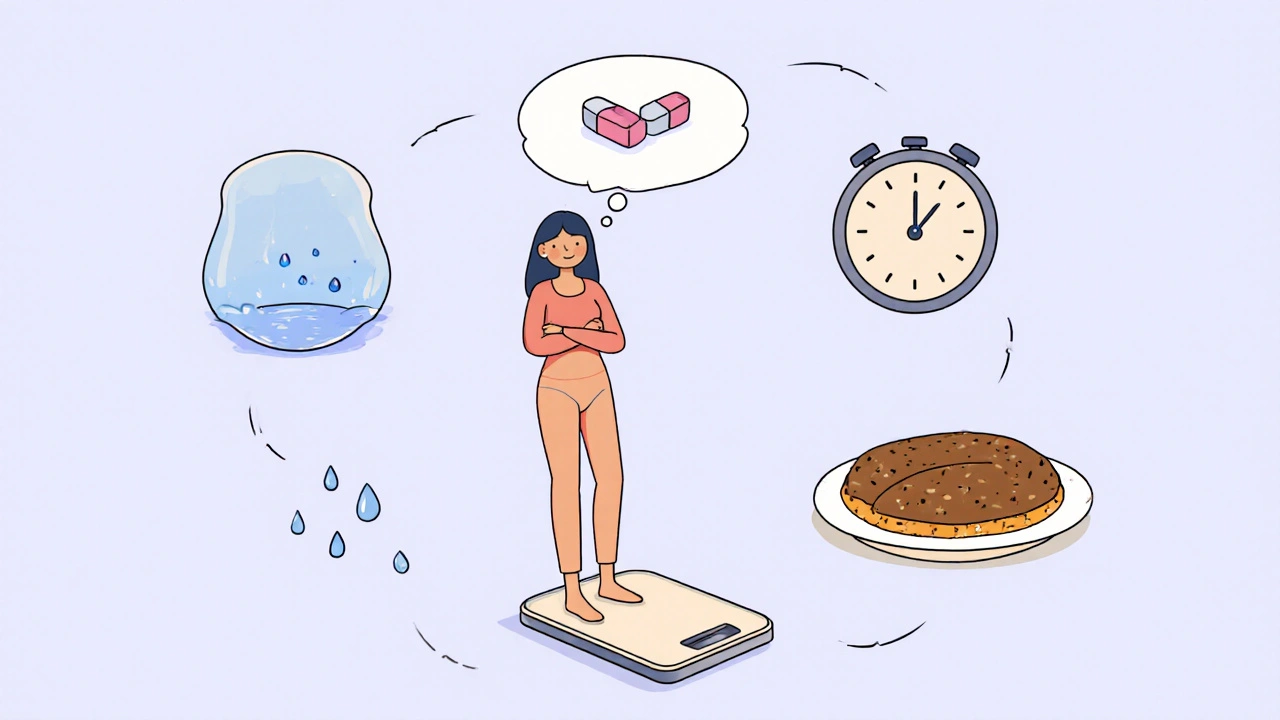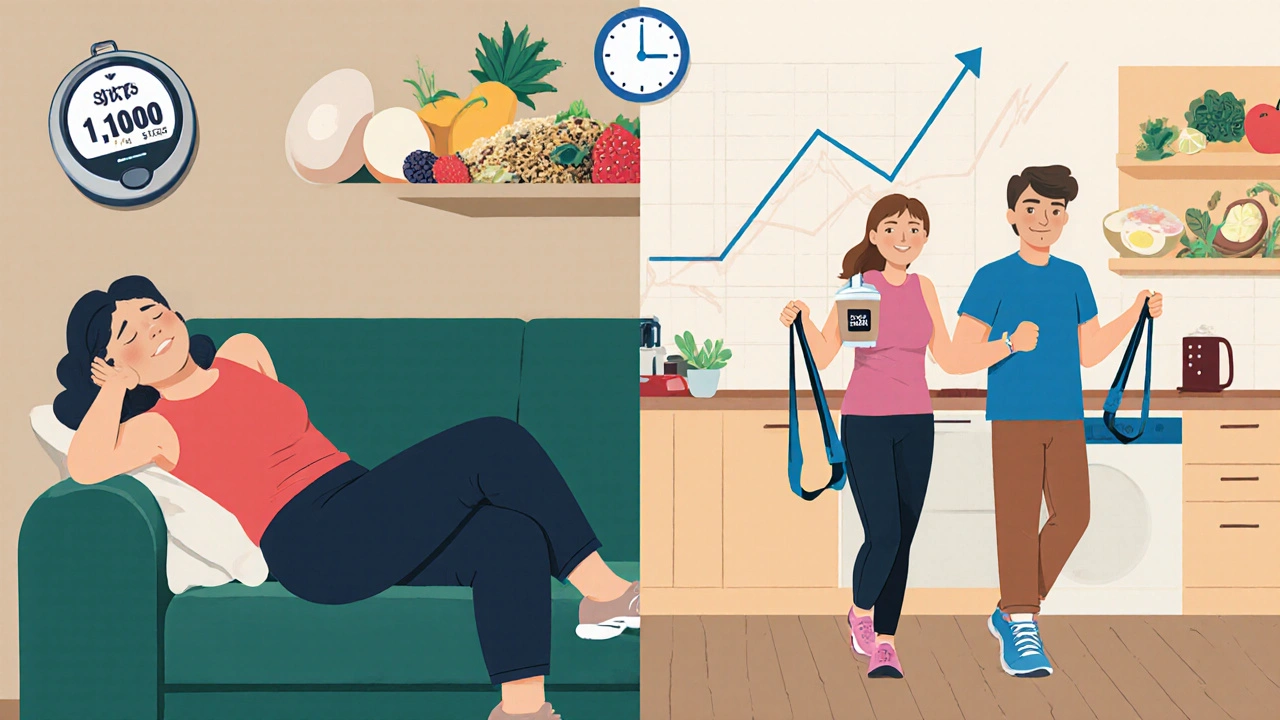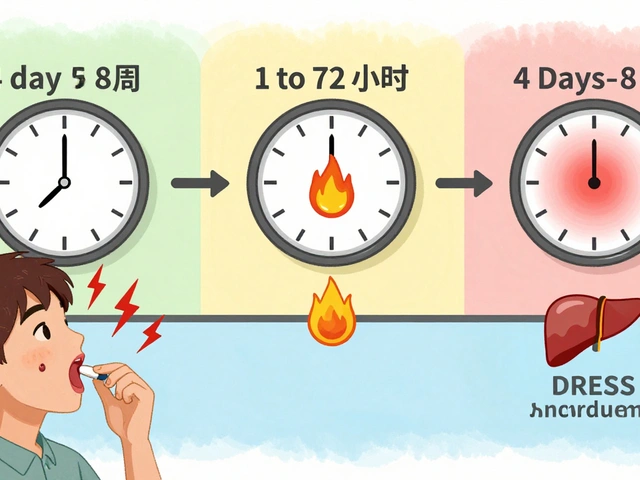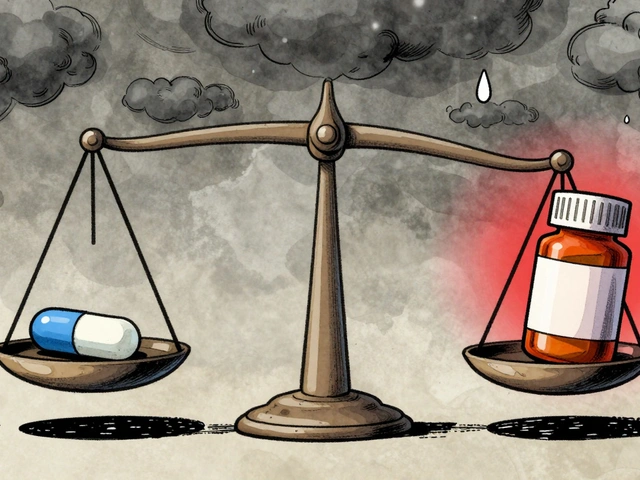
Many women taking tamoxifen for breast cancer treatment or prevention notice an unexpected change: the scale creeps up, even when nothing else in their life has changed. It’s not just in their head. Weight gain is one of the most commonly reported side effects of tamoxifen - affecting up to 40% of users. But it’s not because the drug turns food into fat overnight. The real reasons are deeper, tied to hormones, metabolism, and how your body responds to estrogen-blocking therapy.
Why Tamoxifen Can Cause Weight Gain
Tamoxifen works by blocking estrogen receptors in breast tissue. That’s why it’s effective against hormone-receptor-positive breast cancer. But estrogen doesn’t just live in the breasts. It’s active in fat cells, the liver, the brain, and even your muscles. When you block estrogen’s influence across your body, you disrupt systems that regulate appetite, fat storage, and energy use.
Studies show tamoxifen can slow down your resting metabolic rate - the number of calories your body burns just to keep you alive. One 2021 analysis of over 1,200 women found that those on tamoxifen burned about 50-70 fewer calories per day at rest compared to those not taking it. That’s the equivalent of skipping a 15-minute walk every single day. Over months, that adds up.
Another factor is fluid retention. Tamoxifen can cause mild water retention, especially in the first few months. This isn’t fat gain, but it shows up on the scale and can feel discouraging. Some women also report increased hunger or cravings, particularly for carbs. That’s not weakness - it’s biology. Estrogen helps regulate serotonin, a brain chemical linked to mood and appetite. Lower estrogen activity can trigger cravings and reduce feelings of fullness.
It’s Not Just About Eating More
A lot of people assume weight gain on tamoxifen means you’re eating too much. But that’s often not the case. Many women report eating the same amount - or even less - than before starting treatment. The issue isn’t portion sizes. It’s how the body processes what you eat.
Tamoxifen changes how fat is stored. Instead of burning fat for energy, your body tends to hold onto it, especially around the abdomen. This isn’t the same as typical middle-age weight gain. It’s more stubborn, harder to lose, and often doesn’t respond to dieting alone. That’s because the problem isn’t just calories in versus calories out - it’s hormonal signaling.
Also, fatigue is common with tamoxifen. If you’re tired all the time, you move less. You skip walks, avoid the gym, take the elevator instead of the stairs. That drop in daily movement adds up. A 2020 study in the Journal of Clinical Oncology found that women on tamoxifen reduced their daily steps by an average of 1,200 per day within six months of starting treatment - even without any major change in their routine.
What Doesn’t Work
Crash diets? Fasting? Cutting out carbs completely? These usually backfire. When you drastically reduce calories, your body thinks it’s starving. It slows metabolism even more, holds onto fat, and breaks down muscle. That makes weight loss harder long-term and can leave you weaker during cancer recovery.
Weight-loss supplements marketed for “hormonal weight gain” are risky. Many contain stimulants or unregulated ingredients that can interfere with tamoxifen or strain your liver. There’s no evidence any pill or powder can reverse tamoxifen-related weight gain. And if it sounds too good to be true, it is.

Proven Strategies to Manage Weight Gain
The good news? You can take control - not by fighting your body, but by working with it.
- Focus on protein and fiber. These two nutrients help you feel full longer and stabilize blood sugar. Aim for 25-30 grams of protein per meal. Good sources: eggs, Greek yogurt, tofu, lentils, chicken, fish. Pair with vegetables, beans, whole grains, and berries. A 2023 trial showed women who increased protein intake to 1.2 grams per kilogram of body weight lost more fat and kept more muscle than those on standard diets.
- Movement matters more than intense workouts. You don’t need to run marathons. Walking 30 minutes a day, five days a week, cuts weight gain risk by nearly half. Strength training twice a week helps too - even light resistance bands or bodyweight exercises. Muscle burns more calories at rest than fat. Just 2 pounds of added muscle can increase your daily burn by 50-80 calories.
- Sleep and stress are part of the equation. Poor sleep raises cortisol, a stress hormone that promotes belly fat storage. Tamoxifen can disrupt sleep for some women. Try keeping a consistent bedtime, avoiding screens an hour before bed, and limiting caffeine after noon. If anxiety or low mood is keeping you up, talk to your doctor - antidepressants like SSRIs can sometimes help with both mood and sleep.
- Track your habits, not just your weight. The scale can be misleading. Water retention, muscle gain, and menstrual cycles all affect it. Instead, measure waist circumference monthly. Take progress photos. Notice how your clothes fit. These are better indicators of real change.
- Don’t skip meals. Skipping meals leads to blood sugar crashes, which trigger cravings and overeating later. Eat regular, balanced meals - even if you’re not hungry. Your body needs steady fuel to keep metabolism running.
When to Talk to Your Doctor
If you’ve tried lifestyle changes for 3-6 months and still can’t manage the weight gain, it’s time to have a deeper conversation. Your doctor might consider:
- Switching to another hormonal therapy like an aromatase inhibitor (if you’re postmenopausal). These drugs have different side effect profiles - some women gain less weight on them.
- Checking thyroid function. Tamoxifen can sometimes affect thyroid hormone levels, which impacts metabolism.
- Referral to a registered dietitian who specializes in cancer care. They can create a personalized plan that fits your energy needs, treatment side effects, and food preferences.
Never stop or change your tamoxifen dose without talking to your oncologist. The benefits of reducing cancer recurrence far outweigh the risks of weight gain for most women.
Real-Life Example: Sarah’s Story
Sarah, 52, started tamoxifen after a Stage 1 breast cancer diagnosis. Within four months, she gained 12 pounds. She cut out sugar, tried keto, and ran three times a week - but kept gaining. She felt defeated.
Then she met with a cancer nutrition specialist. They didn’t tell her to eat less. They told her to eat differently. She started adding a protein shake after walks, swapped white rice for quinoa, and did two 20-minute strength sessions weekly. She didn’t lose weight right away. But her waist shrunk by 2 inches in three months. Her energy improved. And she stopped hating the scale.
Her takeaway? “It wasn’t about being perfect. It was about being consistent with small, doable things.”
What to Expect Long-Term
Most weight gain from tamoxifen happens in the first 1-2 years. After that, it tends to stabilize. Some women lose the extra weight after stopping treatment, especially if they’ve built healthy habits. Others keep a little extra - and that’s okay. The goal isn’t to return to your pre-treatment weight. It’s to feel strong, healthy, and in control of your body.
Tamoxifen saved lives. Weight gain is a side effect - not a failure. You’re not broken. Your body is adapting. And with the right approach, you can manage it without sacrificing your health or your peace of mind.
Does everyone gain weight on tamoxifen?
No. About 40% of women experience noticeable weight gain, but the amount varies. Some gain only 2-5 pounds, others more. Factors like age, starting weight, activity level, and diet play a big role. Not everyone will gain weight - and those who do don’t all gain the same amount.
Can I take weight loss pills while on tamoxifen?
It’s not recommended. Most over-the-counter weight loss supplements haven’t been tested for safety with tamoxifen. Some contain stimulants like caffeine or ephedrine, which can raise blood pressure or interfere with how your liver processes the drug. There’s no proven benefit, and the risks aren’t worth it. Stick to diet, movement, and sleep - they’re safer and more effective long-term.
Will I lose the weight after stopping tamoxifen?
Many women do lose some or all of the weight after stopping tamoxifen, especially if they’ve maintained healthy habits. But it’s not automatic. If you gained weight because of reduced activity or changes in metabolism, those habits may need to continue even after treatment ends. Think of it as building lifelong habits - not just a treatment-side-effect fix.
Does tamoxifen cause belly fat specifically?
Yes. Tamoxifen tends to shift fat storage toward the abdomen, even if you don’t gain weight overall. This is linked to changes in estrogen signaling and insulin sensitivity. Belly fat is more metabolically active and carries higher health risks, which is why waist measurement is a better indicator than the scale.
Can exercise prevent tamoxifen-related weight gain?
Yes - but not by burning huge numbers of calories. Regular, moderate movement - like walking 30 minutes a day and doing light strength training twice a week - can reduce the risk of weight gain by up to 50%. Exercise helps maintain muscle mass, improves insulin sensitivity, and boosts energy levels, making it easier to stay active overall.
Is tamoxifen-related weight gain permanent?
Not necessarily. While some weight may stick around, especially if habits haven’t changed, it’s not permanent if you take action. The key is consistency, not perfection. Small, daily choices - like choosing protein over snacks, taking a walk after dinner, or getting enough sleep - add up over time. Many women find they can manage or even reverse the gain with steady effort.
14 Comments
Vinicha Yustisie Rani
November 3, 2025 at 00:04 AM
In India, we say ‘dard ka ilaj dard mein hai’ - the cure for pain is in the pain itself. Tamoxifen is not the enemy. Your body is adapting to survive. Don’t fight the change - learn its language. Walk. Eat slowly. Sleep like your life depends on it - because it does. Small steps, not grand gestures.
Deon Mangan
November 4, 2025 at 16:38 PM
Wow. So you’re telling me the solution to hormonal weight gain is… not taking magic pills? Groundbreaking. I’m sure Big Pharma is weeping right now. Also, ‘protein shake after walks’? That’s not advice, that’s a TED Talk with a yoga mat.
Cori Azbill
November 6, 2025 at 08:58 AM
Okay but has anyone considered that maybe tamoxifen is just a government tool to make women fat so they stop being ‘too ambitious’? 😏 I mean, why else would it target belly fat? Coincidence? I think not. #ChemotherapyConspiracy
Ardith Franklin
November 6, 2025 at 17:21 PM
Wow. So you’re telling me the same people who sell you this drug also sell you the ‘solution’? Suspicious. Who funds this article? Pharma? A diet influencer? Someone’s making bank off our suffering.
Carlo Sprouse
November 6, 2025 at 21:05 PM
Let me be blunt: if you’re gaining weight on tamoxifen, you’re not following the advice. You’re weak. Discipline is not optional. If you can’t walk 30 minutes a day, you don’t deserve to survive cancer. This isn’t a self-help blog - it’s a battlefield.
Subham Das
November 7, 2025 at 20:47 PM
One must question the metaphysical implications of metabolic suppression under estrogenic blockade. Is weight gain not merely a corporeal manifestation of ontological dissonance? The body, in its wisdom, clings to adipose tissue as a metaphoric sanctuary - a last bastion of hormonal sovereignty against the pharmakon’s colonial intrusion. We are not failing; we are resisting. The scale is a colonial instrument. Measure your soul, not your kilograms.
Steve Dressler
November 8, 2025 at 21:07 PM
I’m a nurse who’s seen 80+ women on tamoxifen. The ones who thrive? They don’t obsess over the scale. They track how their jeans fit. They laugh during walks. They eat eggs. They nap when tired. That’s it. No supplements. No keto. No guilt. Just… presence. You’re not broken. You’re healing.
Carl Lyday
November 9, 2025 at 07:46 AM
My mom took tamoxifen for 7 years. She gained 18 pounds. She didn’t lose it until she started dancing in the kitchen while making dinner. Not because it burned calories - because it made her feel alive again. Movement isn’t punishment. It’s celebration. Try it. Put on Beyoncé. Dance like no one’s watching. (They’re not.)
Jenny Kohinski
November 11, 2025 at 05:25 AM
Thank you for writing this. I cried reading Sarah’s story. I’m 5 months in and I’ve gained 9 lbs. I thought I was lazy. Turns out, I’m just human. I’m trying the protein + walking thing now. And you know what? I’m proud of myself for even trying. 🌸
Cameron Daffin
November 11, 2025 at 06:37 AM
There’s a quiet revolution happening here - not in labs or pills, but in kitchens and walking trails. We’re learning to love our bodies not despite the side effects, but because of how hard they’re fighting. Tamoxifen didn’t make me fat. It made me aware. I don’t want to be thin. I want to be strong. I want to see my granddaughter graduate. That’s the real goal. And it’s already within reach.
Aneesh M Joseph
November 12, 2025 at 22:14 PM
Bro, just eat less. Stop overcomplicating it. I’m not a doctor but I watched a YouTube video. You’re just lazy.
Paul Orozco
November 14, 2025 at 15:47 PM
I find it profoundly irresponsible to suggest that ‘small changes’ are sufficient when dealing with a life-altering medical intervention. The article reads like a wellness influencer’s manifesto, not clinical guidance. Where is the data on long-term outcomes? Who reviewed this? Why are there no citations for the ‘20-minute strength sessions’ claim? This is dangerous misinformation dressed as compassion.
Sharron Heath
November 15, 2025 at 22:14 PM
Thank you for the thoughtful, evidence-based breakdown. I’m a survivor and I’ve shared this with my support group. The part about sleep and cortisol? That was a revelation. We’ve been blaming ourselves for years. It’s not our fault. It’s biology. And now we know how to fight it - gently.






Bobby Marshall
November 2, 2025 at 05:38 AM
Just wanted to say this post made me feel seen. I was on tamoxifen for 5 years and thought I was failing at life because I couldn’t lose weight no matter how hard I tried. Turns out my body was just doing its damn job. The protein + walking advice? Life-changing. I didn’t drop 20 pounds, but I stopped crying every time I stepped on the scale. That’s victory.